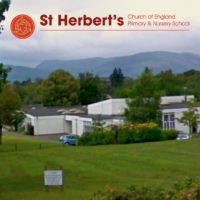For some weeks now we’ve been writing ‘behind the scenes’ of learning power…how it could look; how it might grow; what students might be encouraged to say; what learning friendly cultures could look and feel like; what emotional behaviours does perseverance seem to be made up of? In effect we have been using what’s come to be known as ‘could be’ language: exploring what could be happening for real. But this week we’re delighted to be able to show you what learning power looks like for real. No ifs, no buts, no mights, no coulds, just what it is like in action in a primary school in Cumbria. We even have little clips of video to prove it! Why not take a look…
St Herbert’s Church of England primary school in Keswick lies in one of those idyllic locations….Latrigg seems to be within touching distance and the well known fell Catbells is visible just across Derwent Water. Indeed, Year 4 pupils have just returned from climbing Catbells and spending a night in yurts! But St Herbert’s isn’t only in a fabulous location, it also has a rarefied learning power atmosphere and its students are developing their power to learn with assurance.
Over the next three blogs we will try to give a flavour of what we saw, why we were impressed, how it differs from what we have seen so far, and how you might apply some of this magic in your own classrooms. This week we look at what the children have to say about learning powers: what they are, why they are useful in school and beyond, and how they approach making mistakes.
In the first clip a group of six children from Years 3 to 6 came along to offer their thoughts about learning power. There was no script, there had been no practice. The teacher simply drew them together and asked them what good learners do, which learning powers they found useful and how the classrooms helped them to learn.
The children are able to talk fluently about several learning powers and how these work together. When children are as articulate as this about learning powers or muscles you know that they are aware that it’s working for them and those ways of learning will become their learning capital for life. Such confidence takes time to develop, and while children are introduced to the ideas in Reception, it’s been in the last two years, when teachers began to design their lessons around learning behaviours, that children’s understanding has really taken off.
Our second clip shows two Year 6 children who are engaged in a maths lesson…more about that next time. They have been totally absorbed, as a pair, in their first task. We noticed that they had happily rubbed things out both on their whiteboards or in their maths books and decided to explore their feelings about making mistakes.
As we suspected these children have no fear of making mistakes, seeing them as a natural part of learning. Grace explains that she sometimes rubs out mistakes because she knows it’s wrong and she can improve it. She tries it again and if it’s wrong again she puts a line through it. What she’s trying to avoid is getting her book too messy! This shows that Grace is monitoring her work as she goes along, checking that it appears to be progressing, yet leaving enough evidence of earlier mistakes for her or her teacher to learn from. Her perseverance with tricky tasks never looked laboured or stressful. She just calmly got on with the ups and downs of learning.
In our final clip this week we go back to the group of children in clip 1. Here they are talking about how their learning powers will help them in their future lives. They speak with self assurance and clear knowledge of themselves as learners. These children are already confident meta-cognitive learners. They have gone well beyond the ‘I can’t do it yet’ belief stage because now they know they have the cognitive, emotional and social tools to enable them to engage with most learning encounters..in school and out. Having the belief is one thing, knowing you are developing the necessary tools is quite another.
Next week we’ll take a look at the Year 6 maths lesson that Grace and Elijah were enjoying in clip 2. The lesson is based around three learning behaviours, so making the learning process visible.
And of course we all hope that in the years ahead the learning behaviour …planning…. will help Joshua to find a wife.


No comments yet.